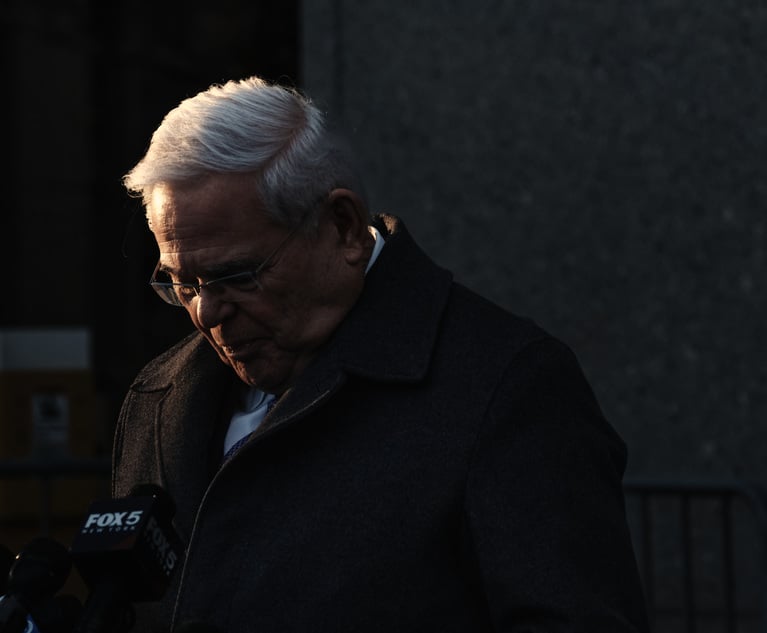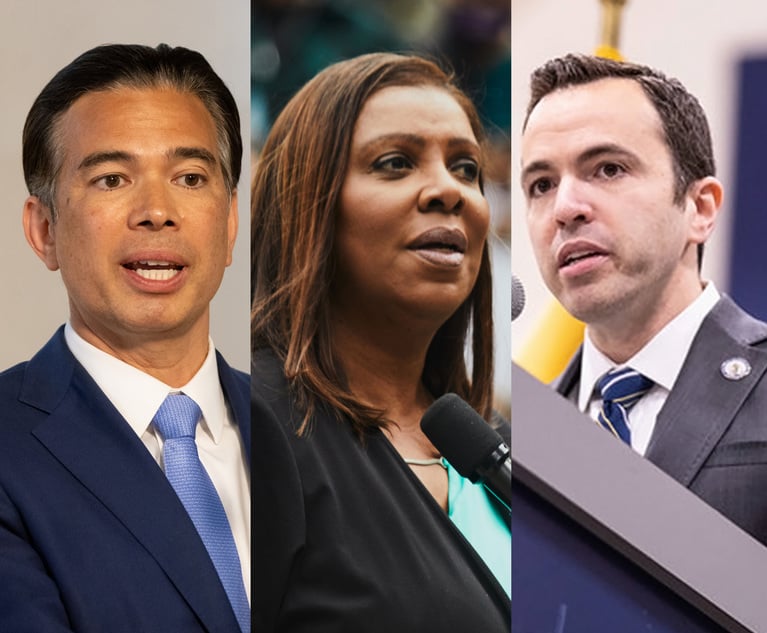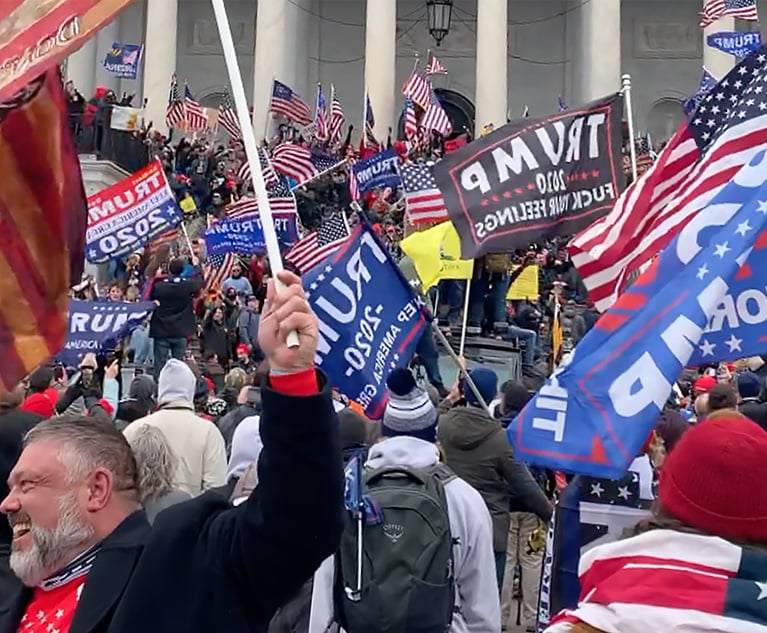DOJ's Revamped Merger Review Process: A Little Bit of Give and Take
Antitrust Trade and Practice columnists Shepard Goldfein and Karen Hoffman Lent outline the DOJ's proposed plan to streamline the DOJ's merger review process and discuss their implications for merging parties and merger review at large.
November 09, 2018 at 02:40 PM
10 minute read
 Shepard Goldfein and Karen Hoffman Lent
Shepard Goldfein and Karen Hoffman Lent
The average amount of time the antitrust agencies spend reviewing significant mergers has ballooned in recent years. In 2013, the Department of Justice (DOJ) and the Federal Trade Commission (FTC)—the federal agencies charged with evaluating prospective transactions under our nation's antitrust laws—spent an average of 7.1 months reviewing each merger that went through a Second Request under the Hart-Scott-Rodino Antitrust Improvements Act (HSR Act). That figure grew to 10.8 months by late 2017.
This significant increase has not been lost on top officials at the DOJ. Speaking at the 2018 Global Antitrust Enforcement Symposium on Sept. 25, 2018, Assistant Attorney General Makan Delrahim, head of the DOJ's Antitrust Division, expressed concern over the current state of affairs, citing waste of both public and private resources as the result of lengthy merger review. With the hope of addressing this issue, he unveiled a plan to streamline the DOJ's merger review process.
We outline below the DOJ's proposed changes and discuss their implications for merging parties and merger review at large. Mr. Delrahim's proposed reforms seem likely to at least marginally reduce the length of the average merger review. But that effect will not come without cost. While the business community can breathe a collective sigh of relief at the DOJ's goal of minimizing the burden of merger review, parties will be expected to more fully cooperate than ever before. As Mr. Delrahim hinted in the very headline of his remarks, quoting Rob Base and DJ E-Z Rock's multiplatinum hit, “it takes two to make a thing go right.”
The Current State of Affairs
Parties whose transaction is subject to HSR begin the merger review process by filing the requisite notification forms and paying a filing fee. The agency tasked with review has 30 days to review the transaction. During this stage, the agency may ask the parties to voluntarily produce information concerning the transaction. It must then determine whether it will allow the merger to move forward without delay or issue a Second Request for additional information. The parties also may “pull and refile” their HSR forms, restarting the clock with the hope that the reviewing agency will get comfort with the transaction without issuing a Second Request or issue a Second Request that is narrower in scope.
If the agency issues a Second Request, the merger review clock stops. The agency will meet with the parties to negotiate a timing agreement that covers the scope of the information requested and the length of the inquiry. Among items included in the timing agreement are the number of custodians whose files the agency will review and the number of depositions the agency will conduct. At present, this procedural step is key, as the Second Request phase can last six to eight months or more.
To comply with a Second Request, the parties must produce hundreds of thousands—if not millions—of internal documents, report a significant amount of financial and market data and provide narrative responses to the agencies' questions. To obtain more information, the agency may depose executives, other organizational employees and third parties. The agency also may issue civil investigative demands (CIDs) of third parties, which further impact the agency's ability to timely review the transaction due to slow and incomplete compliance.
After the parties have certified compliance with the Second Request, another 30-day waiting period begins, throughout which the parties, their counsel and their economists meet with the agency to discuss its view of the deal. The agency may ask for extensions to allow it additional time to review the parties' submissions and/or negotiate a consent decree. If the agency requires the parties to divest assets to alleviate the transaction's likely anticompetitive effects, it will typically demand that the parties identify an upfront buyer, adding even more time to the process.
The Content of the Proposed Changes
Given the complexities brought about by the HSR procedures described above and ever-lengthening merger review timelines, Mr. Delrahim announced a series of reforms with the goal of resolving most merger investigations within six months of filing.
The Initial Waiting Period. The DOJ suggested several reforms regarding the initial HSR waiting period. First, the DOJ hopes to meet with parties early to discuss the parties' business rationale for the deal and to exchange any facts it understands will be important to its analysis. Second, the DOJ will publish a model voluntary request letter, which it expects parties will use to better prepare for providing information to the agencies within the first 30-day period. Finally, when the parties need to pull-and-refile, the DOJ will put in place an investigative plan, allowing it to determine whether to issue a Second Request as soon as possible and, if it does, whether to narrow the issues.
Navigating the Agency's Second Request. The DOJ also plans to implement several key reforms to expedite the Second Request process. As Mr. Delrahim noted, timing agreements and extensions are inconsistent with the process Congress outlined in the HSR Act, which mandates only the two 30-day waiting periods enumerated within. To bring the process more in line with the HSR Act, the DOJ intends to limit the scope of timing agreements, capping the number of custodians at 20 per party and seeking no more than 12 depositions in most cases. The DOJ will also publish a model timing agreement so parties know what to expect and do not get bogged down negotiating the procedures by which they make their disclosures. Once the parties certify compliance with the Second Request, the DOJ will make its decision in under 60 days.
These benefits will impose additional burdens on merging entities. Parties to the transaction will be expected to produce documents and data faster and earlier. And as part of the production, the DOJ has expressed hope that counsel will limit the number of documents over which parties claim privilege, noting a particular concern about “privilege log gamesmanship.” Should the agency challenge the merger, it will further expect parties to agree to a longer post-complaint discovery period.
Finally, the DOJ will take steps to ensure that third parties timely comply with CIDs. Where such parties fail to comply by missing deadlines or providing incomplete documentation, the DOJ will proceed with enforcement actions.
Remedies Reforms. The DOJ also plans to overhaul its remedies policy and announced that it has withdrawn the 2011 Antitrust Division Policy Guide to Merger Remedies. It will issue an updated policy in several months. For now, the 2004 Antitrust Division Policy Guide to Merger Remedies will direct remedies analyses.
Other Reforms. Citing concerns that parallel foreign investigations of mergers lengthen the domestic review process, the DOJ also plans to improve coordination with foreign actors, aligning timelines with those of other jurisdictions. Moreover, it will periodically release statistics on the average time it takes to complete a Second Request to hold itself accountable for delays.
What These Changes Mean
The proposed changes will likely yield positive results in the form of at least marginally expedited merger review schedules. Even without these reforms, the average duration of significant merger investigations is already down from 10.8 months in late 2017 to 9.8 months through 2018. But reducing the length of investigations to six months is a tall order that will be difficult to achieve.
Regardless of the reforms, the length of any given review will continue to be case specific. The more complex the transaction at issue, and the more antitrust concerns the transaction raises, the lengthier the DOJ investigation is likely to be. Though the new policy sets caps on the number of custodians and depositions the DOJ will seek in its investigations, Deputy Assistant Attorneys General will still have discretion to pursue more custodians and depositions and extend the DOJ's time to consider a transaction. Parties can expect the DOJ to invoke this discretion when reviewing transactions that substantially increase market concentration, that merge close competitors, or that have drawn significant industry or public scrutiny.
While the hard caps on custodians and depositions will likely accelerate the process, the agency's publication of model request letters and timing agreements will likely not. Antitrust counsel often already know the kind of information parties will be expected to share after filing and the kind of provisions normally included within timing agreements. Moreover, inconsistencies between the model agreement and the actual agreement that the DOJ seeks may result in back and forth negotiations that could lead to further delay. Notably, the DOJ's 2016 model Second Request has not amounted to efficiency gains. For these reforms to create such gains, the DOJ must commit to adhering to its model agreement in the vast majority of cases, as the FTC has already done.
The DOJ's model timing agreement may look very different from that which the FTC published in August, creating further asymmetries between the procedures the two antitrust agencies utilize. As is, the FTC's timing agreement appears to allow significantly more time for review than will the DOJ's. With the agencies following different protocols, merging parties could face distinct obstacles depending on which antitrust agency reviews the transaction, rendering clearance decisions even more important going forward.
Furthermore, the DOJ's reinstitution of its 2004 remedies policies has several significant implications. It signals a return to the agency's strong preference for structural relief, as the 2004 guide strongly disfavored conduct remedies. Though the DOJ has continued to demonstrate a preference for structural relief since 2011, the 2011 guide recognized that in some cases, a combination of structural and conduct remedies is most appropriate. In addition, the DOJ will be less likely to pursue crown jewel provisions, which the 2011 guide permitted in exceptional cases.
Perhaps the most significant takeaway regards the extent to which the DOJ will expect cooperation from merging parties. Parties will be expected to make significant concessions. Going forward, the onus will be on parties to produce documents faster and earlier, agree to a lengthier post-complaint discovery period before even knowing whether such a period will be necessary, meet with regulators early on in the process and invoke privilege cautiously. These demands are substantial and may create difficulties of their own, increasing the cost of compliance at certain junctures of the review process.
It remains to be seen whether these proposed reforms, once implemented, will ease the burdens associated with the DOJ merger review process. The DOJ's willingness to attempt to speed up that process is a good start.
Shepard Goldfein and Karen Hoffman Lent are partners at Skadden, Arps, Slate, Meagher & Flom. Michael Lanci, a law clerk at the firm, assisted in the preparation of this column.
This content has been archived. It is available through our partners, LexisNexis® and Bloomberg Law.
To view this content, please continue to their sites.
Not a Lexis Subscriber?
Subscribe Now
Not a Bloomberg Law Subscriber?
Subscribe Now
NOT FOR REPRINT
© 2025 ALM Global, LLC, All Rights Reserved. Request academic re-use from www.copyright.com. All other uses, submit a request to [email protected]. For more information visit Asset & Logo Licensing.
You Might Like
View All

'You Became a Corrupt Politician': Judge Gives Prison Time to Former Sen. Robert Menendez for Corruption Conviction
5 minute read
Federal Judge Pauses Trump Funding Freeze as Democratic AGs Plan Suit
4 minute readTrending Stories
- 1Gunderson Dettmer Opens Atlanta Office With 3 Partners From Morris Manning
- 2Decision of the Day: Court Holds Accident with Post Driver Was 'Bizarre Occurrence,' Dismisses Action Brought Under Labor Law §240
- 3Judge Recommends Disbarment for Attorney Who Plotted to Hack Judge's Email, Phone
- 4Two Wilkinson Stekloff Associates Among Victims of DC Plane Crash
- 5Two More Victims Alleged in New Sean Combs Sex Trafficking Indictment
Who Got The Work
J. Brugh Lower of Gibbons has entered an appearance for industrial equipment supplier Devco Corporation in a pending trademark infringement lawsuit. The suit, accusing the defendant of selling knock-off Graco products, was filed Dec. 18 in New Jersey District Court by Rivkin Radler on behalf of Graco Inc. and Graco Minnesota. The case, assigned to U.S. District Judge Zahid N. Quraishi, is 3:24-cv-11294, Graco Inc. et al v. Devco Corporation.
Who Got The Work
Rebecca Maller-Stein and Kent A. Yalowitz of Arnold & Porter Kaye Scholer have entered their appearances for Hanaco Venture Capital and its executives, Lior Prosor and David Frankel, in a pending securities lawsuit. The action, filed on Dec. 24 in New York Southern District Court by Zell, Aron & Co. on behalf of Goldeneye Advisors, accuses the defendants of negligently and fraudulently managing the plaintiff's $1 million investment. The case, assigned to U.S. District Judge Vernon S. Broderick, is 1:24-cv-09918, Goldeneye Advisors, LLC v. Hanaco Venture Capital, Ltd. et al.
Who Got The Work
Attorneys from A&O Shearman has stepped in as defense counsel for Toronto-Dominion Bank and other defendants in a pending securities class action. The suit, filed Dec. 11 in New York Southern District Court by Bleichmar Fonti & Auld, accuses the defendants of concealing the bank's 'pervasive' deficiencies in regards to its compliance with the Bank Secrecy Act and the quality of its anti-money laundering controls. The case, assigned to U.S. District Judge Arun Subramanian, is 1:24-cv-09445, Gonzalez v. The Toronto-Dominion Bank et al.
Who Got The Work
Crown Castle International, a Pennsylvania company providing shared communications infrastructure, has turned to Luke D. Wolf of Gordon Rees Scully Mansukhani to fend off a pending breach-of-contract lawsuit. The court action, filed Nov. 25 in Michigan Eastern District Court by Hooper Hathaway PC on behalf of The Town Residences LLC, accuses Crown Castle of failing to transfer approximately $30,000 in utility payments from T-Mobile in breach of a roof-top lease and assignment agreement. The case, assigned to U.S. District Judge Susan K. Declercq, is 2:24-cv-13131, The Town Residences LLC v. T-Mobile US, Inc. et al.
Who Got The Work
Wilfred P. Coronato and Daniel M. Schwartz of McCarter & English have stepped in as defense counsel to Electrolux Home Products Inc. in a pending product liability lawsuit. The court action, filed Nov. 26 in New York Eastern District Court by Poulos Lopiccolo PC and Nagel Rice LLP on behalf of David Stern, alleges that the defendant's refrigerators’ drawers and shelving repeatedly break and fall apart within months after purchase. The case, assigned to U.S. District Judge Joan M. Azrack, is 2:24-cv-08204, Stern v. Electrolux Home Products, Inc.
Featured Firms
Law Offices of Gary Martin Hays & Associates, P.C.
(470) 294-1674
Law Offices of Mark E. Salomone
(857) 444-6468
Smith & Hassler
(713) 739-1250







